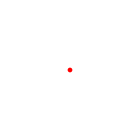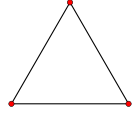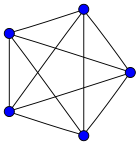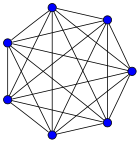Complete graph
| Complete graph | |
|---|---|
 K7, a complete graph with 7 vertices |
|
| Vertices | n |
| Edges | n(n − 1) / 2 |
| Diameter | 1 |
| Girth | 3 if n ≥ 3 |
| Automorphisms | n! (Sn) |
| Chromatic number | n |
| Chromatic index | n if n is odd n-1 if n is even |
| Properties | (n-1)-regular Symmetric graph Vertex-transitive Edge-transitive Unit distance Strongly regular Integral |
| Notation |  |
In the mathematical field of graph theory, a complete graph is a simple graph in which every pair of distinct vertices is connected by a unique edge.
Contents |
Properties
The complete graph on n vertices has n(n-1)/2 edges, and is denoted by  (from the German komplett[1]). It is a regular graph of degree
(from the German komplett[1]). It is a regular graph of degree  . All complete graphs are their own cliques. They are maximally connected as the only vertex cut which disconnects the graph is the complete set of vertices. The complement graph of a complete graph is an empty graph.
. All complete graphs are their own cliques. They are maximally connected as the only vertex cut which disconnects the graph is the complete set of vertices. The complement graph of a complete graph is an empty graph.
Geometry and topology
A complete graph with n nodes represents the edges of an (n-1)-simplex. Geometrically K3 forms the edge set of a triangle, K4 a tetrahedron, etc. The Császár polyhedron, a nonconvex polyhedron with the topology of a torus, has the complete graph K7 as its skeleton. Every neighborly polytope in four or more dimensions also has a complete skeleton.
K1 through K4 are all planar graphs. However, every planar drawing of a complete graph with five or more vertices must contain a crossing, and the nonplanar complete graph K5 plays a key role in the characterizations of planar graphs: by Kuratowski's theorem, a graph is planar if and only if it contains neither K5 nor the complete bipartite graph K3,3 as a subdivision, and by Wagner's theorem the same result holds for graph minors in place of subdivisions.
Examples
Complete graphs on n vertices, for  between 1 and 12, are shown below along with the numbers of edges:
between 1 and 12, are shown below along with the numbers of edges:
 |
 |
 |
 |
|---|---|---|---|
 |
 |
 |
 |
 |
 |
 |
 |
 |
 |
 |
 |
 |
 |
 |
 |
 |
 |
 |
 |
Applications
Since a complete graph contains all n(n-1)/2 possible edges, it gives a quadratic upper bound on the number of connections in large connected systems like social and computer networks.
References
- ↑ David Gries and Fred B. Schneider, A Logical Approach to Discrete Math, Springer, 1993, p 436.
External links
- Counting Paths and Cycles in Complete Graphs. Results are available Mehdi Hassani, Cycles in graphs and derangements, Math. Gaz. 88(March 2004) pp. 123-126 (reprint) or here
- Weisstein, Eric W., "Complete Graph" from MathWorld.